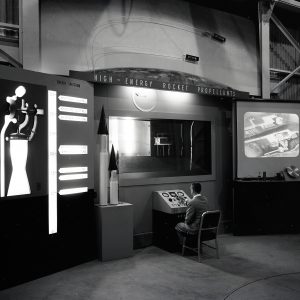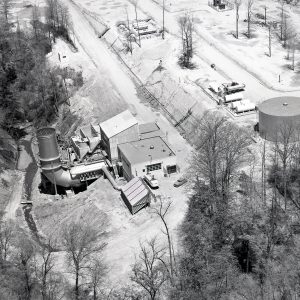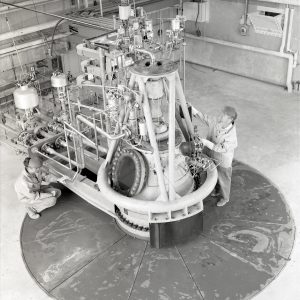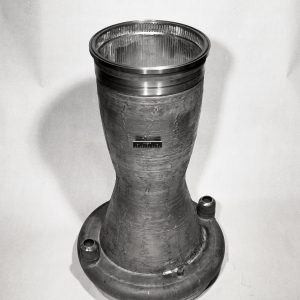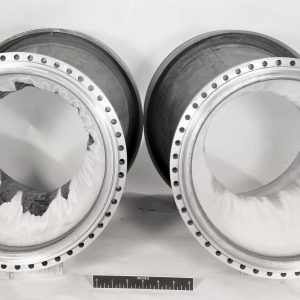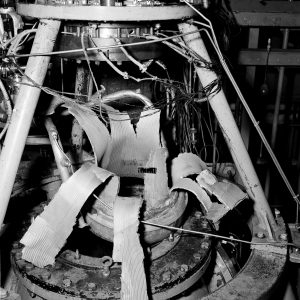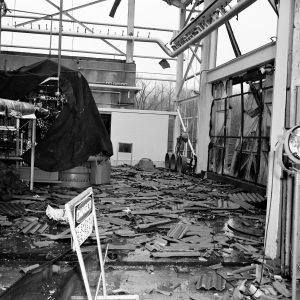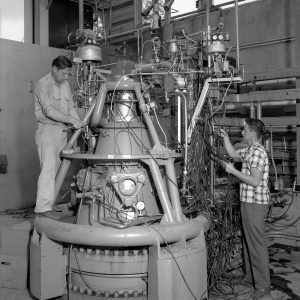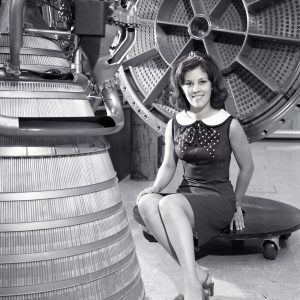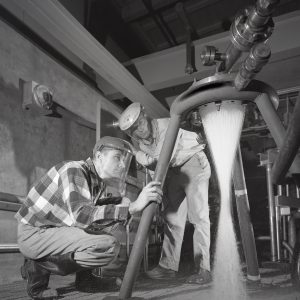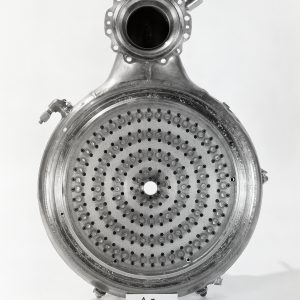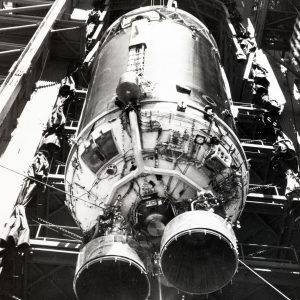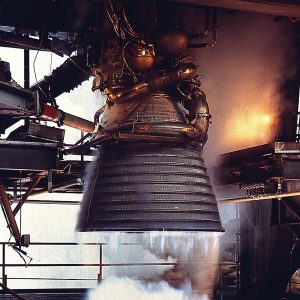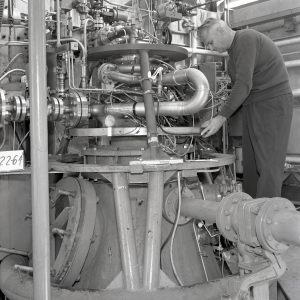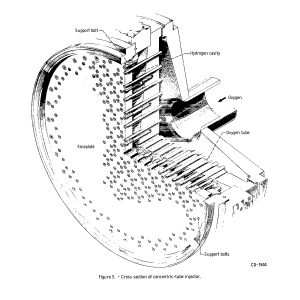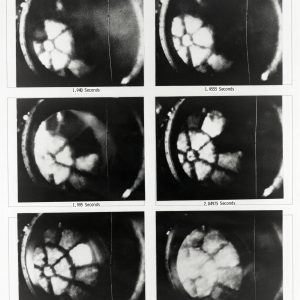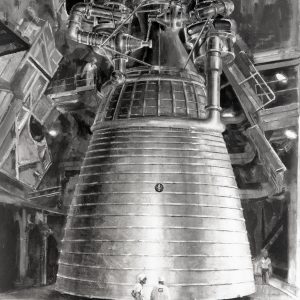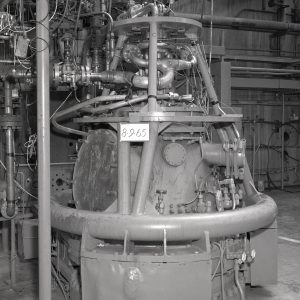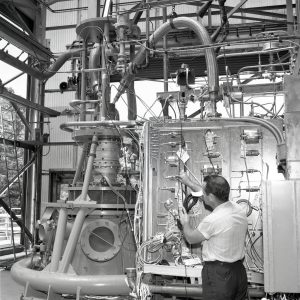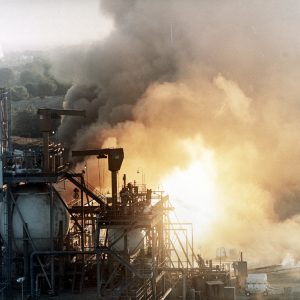Apollo Era Testing
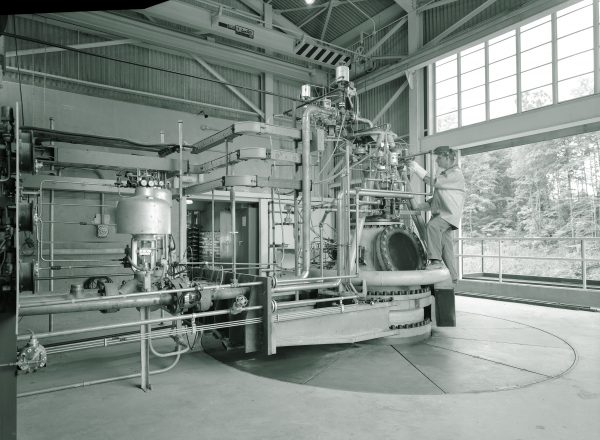
Just weeks after the completion of the Rocket Engine Test Facility (RETF), the Soviet Union ushered in the Space Age with the launch of Sputnik I. The focus of rocket research quickly pivoted from military applications to space exploration as the US strove to prove its technical competence. The RETF made major contributions to new hydrogen propulsion systems for the space program in the 1960s.
Introduction
Events were rapidly transpiring in the fall of 1957. The Soviet Union launched Sputnik I on Oct. 4, and the significantly larger Sputnik II on Nov. 3. Congress held hearings to debate the status of the nation’s missile development. The National Advisory Committee for Aeronautics (NACA), military, and other groups scrambled to determine the requirements and organization of a national space program. By April 1958, President Dwight Eisenhower decided to create a new civilian space agency around the core of the NACA laboratories. On Oct. 1, 1958, the Lewis Flight Propulsion Laboratory was renamed the Lewis Research Center and enveloped into the new National Aeronautics and Space Administration (NASA).
The RETF conducted its first test on Aug. 15, 1957 and was highlighted at the NACA’s 1957 Inspection in early October. The RETF began performing tests of basic experimental engines with traditional rocket fuel and liquid hydrogen. As the space program expanded in the early 1960s, the RETF helped resolve combustion instability issues with commercially produced rocket engines for the Saturn and Centaur vehicles used for the Apollo Program. Combustion instability, sometimes referred to as “screech,” was caused by pressure changes in the engine’s combustion chamber during firing. It could lead to reduced thrust, deformation of the chamber wall, and ultimately engine failure.
Documents
- NACA Lewis 1957 Transformation (2017)
- 1957 Inspection Brochure
- High Energy Rocket Propellants talk (1957)
Early Testing
The RETF began testing on Aug. 15, 1957, with the successful firing of a 20,000-pound thrust rocket engine operating on regular rocket propellant and liquid oxygen. Almost immediately, however, the engineers began taking steps to see how the facility would handle more exotic fuels. These studies began on Nov. 14, 1957, with the test of a gaseous hydrogen and liquid oxygen-fueled rocket engine. By the spring of 1958, they began operating engines using liquid hydrogen. In addition, records indicate that they also tested engines using a hydrogen and fluorine combination from 1957 to 1959. By the 1960s, reactants such as nitrogen tetroxide, unsymmetrical dimethyl hydrazine, and fluorine were increasingly used in tests at the RETF.
The RETF was able to evaluate novel component designs and transfer viable concepts to other research facilities for larger scale testing. The sub-scale testing produced useful and cost-effective design data with minimal use of expensive fuels and oxidizers. The coordination between research scientists and RETF engineers allowed numerous theoretical questions to be answered through direct experimentation.
The RETF proved to be an excellent facility to develop and test injectors to combat combustion instability. The RETF was able to develop and test a wide range of injectors, including sliding, eight-element, zoned, and concentrated pattern injectors. The tests gave research engineers the opportunity to see the effect of different variables on injector designs.
Documents
- Performance of Gaseous Hydrogen and Liquid Hydrogen in 20k Engine (1959)
- Experiments with Hydrogen and Oxygen in Regenerative Engines (1960)
Pratt & Whitney RL-10
In the late 1950s, Pratt & Whitney developed the world’s first commercial liquid-hydrogen rocket engine, the RL‒10. General Dynamics Corporation incorporated two of the 15,000-pound thrust engines into its new Centaur upper-stage rocket. When President Kennedy announced in 1961 that the U.S. would send a man to the Moon, NASA decided to use the unproven Centaur to launch a series of Surveyor spacecraft to explore the lunar surface. In 1961 Pratt & Whitney called upon NASA Lewis’s expertise in hydrogen propulsion systems to resolve a series of troubling problems with the RL‒10, including combustion instability caused by its fuel injectors.
Pratt & Whitney made regular visits to the RETF to learn about a new concentric tube injector that Lewis developed specifically to handle liquid hydrogen and liquid oxygen. Pratt & Whitney eventually adopted the concentric injector but there were problems when the hot gases within the combustion chamber warped the injector’s faceplate. RETF engineers responded by developing and testing a porous material called Rigi-Mesh for the faceplate and fashioning a new injector that resembled a large, shallow mesh colander. The holes in the mesh allowed gaseous hydrogen to flow through to cool the faceplate, which diminished the warping. This injector design was not only successfully used in the RL‒10 engine, but also Rocketdyne’s J‒2 and the Space Shuttle Main Engine.
In October 1962, NASA transferred the management of the Centaur Program from Marshall Space Flight Center in Huntsville, Alabama, to Lewis Research Center. Lewis expertise with liquid hydrogen propulsion was a primary reason for the change. Lewis managed the program for the next 35 years, and oversaw the launches of Surveyor and scores of satellites and space probes
Documents
- Taming Liquid Hydrogen: The Centaur Upper Stage Rocket
- Unconventional Cryogenics from Stages to Saturn
- Effect of Injector Face Configurations on Screech(1966)
- Chamber Shape Effects on Combustion Instability (1967)
Rocketdyne’s J‒2 and F‒1
Lewis’ liquid hydrogen studies also influenced NASA’s decision in 1960 to have Rocketdyne develop the 200,000-pound thrust liquid hydrogen and liquid oxygen J‒2 engine for the upper stages of the Saturn launch vehicle. Like the RL‒10, the J‒2 experienced combustion instability. Rocketdyne also developed the 1.5-million-pound-thrust F‒1 engines for Saturn’s first stage. These massive engines, which ran on kerosene and liquid oxygen, also experienced serious combustion instability problems. This instability caused an explosion of an F‒1 on a test stand in June 1962 that placed the entire Apollo Program in jeopardy.
A team of Lewis engineers worked with Rocketdyne and the Marshall Space Flight Center to resolve the issue. Lewis decided to investigate several theories on its causes in the RETF. Between 1962 and the early 1970s, the RETF tested hundreds of different injectors and combustion chambers designed in-house and from industry. By the mid-1960s, both the F‒1 and J‒2 incorporated concentric-tube injectors based on designs by NASA Lewis engineers and the combustion instability issue was resolved. It is now widely accepted that use of the J‒2 liquid hydrogen engine gave the US a decisive advantage in the race to the Moon.
Documents
- Effect of Propellant Injection Velocity on Screech (1966)
- Investigation of Acoustic Liners to Suppress Screech (1966)
- Evaluation of Screech Suppression Concepts (1967)
- Summary of Liquid Rocket Acoustic Instability Studies (1968)
Aerojet M‒1
From 1962 to 1966, the RETF studies also explored combustion instability in Aerojet’s 1.23-million pound thrust M‒1 engine. The M‒1 was a liquid hydrogen engine for the upper stage of the Nova rocket. NASA planned on using the Nova launch vehicle, which would be more powerful than the Saturn, to send a manned mission directly to the Moon. RETF testing determined that the inclusion of baffles in the M‒1 combustion chamber sufficiently reduced instability. NASA’s decision in 1962 to use a lunar-orbit-rendezvous approach for the Moon rather than a direct-ascent meant that the Nova would not be needed for the Apollo Program. NASA ultimately cancelled the M‒1 program in 1966, but kept the Nova rocket on the drawing board for future missions beyond the Moon.
Documents
- M-1 Injector Development (1968)
- M-1 Subscale Injector Tests (1967)
- Injector Element Detail Effects on Screech (1974)
- Advanced Chemical Rockets Inspection Talk (1966)

